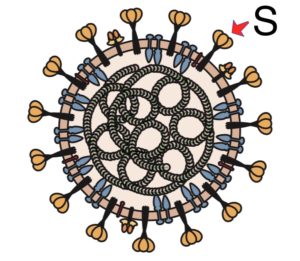

Don’t believe the headlines that SARS-CoV-2 is becoming more transmissible! Virologists are making conclusions that are not justified by the data.
SARS-CoV-2 virus isolates from many parts of the world have a single amino acid change in the spike protein, D614G. This observation in itself doesn’t mean very much. It could be that the change arose early in the outbreak and as this virus spread to other areas it was maintained because it has no fitness cost. We call this behavior ‘founder effect’. Whether the change has been selected for – what we would call ‘positive selection’, as claimed by many virologists, needs to be proven by experiments that have not been done.
The D614G change appears to make the virus more infectious in cells in culture. However, there are limitations to the conclusions that may be drawn from these data. First, cells that have been used are irrelevant to human transmission, such as a kidney cell line (VERO) from Vervet monkeys. I would like to see data from cultures of human respiratory epithelial cells, including airway-liquid cultures and lung organoids. Second, SARS-CoV-2 was not used for these experiments, but pseudotyped viruses – recombinant retroviruses or vesicular stomatitis virus with the SARS-CoV-2 spike glycoprotein gene inserted. The reason for this approach is that working with SARS-CoV-2 requires a BSL-3 laboratory which is not easy to come by. Nevertheless, even if all these issues were addressed, do we really think that results in cell culture tell us anything about human to human transmission? Seriously, virology colleagues? A monolayer of cells in culture in no way compares with the architecturally complex respiratory epithelium with mucus, antibodies, innate and adaptive responses.
I don’t mention using an animal model to assess SARS-CoV-2 transmission potential because there are no good models (yet) for animal to animal transmission of the virus.
I can think of experiments that could be done to determine if viruses with D614G behave differently in humans, but they have not been done. One approach would be to determine if the change leads to higher shedding of infectious virus from the upper tract. One study reported higher levels of viral RNA in the upper tract of patients infected with 614G compared with patients infected with 614D. This observation is meaningless, because everyone knows that nucleic acids detected by PCR does not always mean that infectious virus is present. Increased RNA might be a consequence of a change in the viral RNA polymerase caused by another mutation that accompanies the spike change. What needs to be done is to measure the levels of INFECTIOUS VIRUS shed from the upper respiratory tract of humans infected with either variant. Even then I would argue that the results cannot be interpreted, because we do not know how much of an increase in virus shedding would lead to an increase in transmission. Would twofold more virus be enough? Fivefold? Tenfold? A thousand fold? Anyone who says they know is wrong.
We know that the dispersion factor, k, of SARS-CoV-2 is 0.1, which means that about 10% of cases lead to 80% of spread. Which virus are these individuals transmitting, 614D or 614G? The results would contribute to an understanding of the role of this amino acid change in transmission.
It’s unfortunate that during a serious outbreak, rigorous science appears to be relegated to the back seat. You might remember during the 2015 Ebolavirus outbreak in West Africa, a viruses with a single amino acid change in the spike protein arose early and predominated. This change made the virus more infectious in cells in culture in the laboratory, but was never shown to have any effect on human transmission. In a nonhuman primate model, the change actually reduced virulence of the virus. Whether the predominance of virus isolates with the amino acid change was a founder effect or positive selection was never determined.
An important consideration is to identify the selection pressure for SARS-CoV-2 viruses with increased transmission. By the time the virus was detected in China late in 2019, it was already very good at transmitting among humans. I fail to see what selection pressure would lead to the emergence of such a variant.
The D614 change does not appear to change the virulence of SARS-CoV-2, nor its ability to be neutralized by antibodies. Let’s toss all the above arguments aside and assume that D614G increases human transmission. What should we do? Wear face masks, avoid large gatherings of people, embrace physical distancing. All of which are already being done – or are they?

Pingback: No evidence for increased human transmission of SARS-CoV-2 – Virology Hub
Hello Prof, you have a good hypothesis which none are backed by experimental results, hence your opinion cannot disapprove the evidence on ground. It will be nicer if you can carry out experiments on the appropriate cell lines to demonstrate if this mutation DOES REALLY have an effect on the ability of the virus to spread easily. As long as we don’t have this data, we can’t say otherwise. Thank you
Pingback: Why this coronavirus mutation is not cause for alarm | Best loan credits
Pingback: Why this coronavirus mutation is not cause for alarm - TangoBuddy
Pingback: COVID-19 Update: Several Scientists Debunk Claims Mutation Makes Coronavirus More Dangerous » USA Daily | UsDaily.net
Pingback: National geography geography Why this coronavirus mutation is not cause for alarm - SpotOn11 News
Pingback: Why this mutation of the coronavirus is not a cause for alarm | CoRona 24 News
Pingback: Waarom deze mutatie van het coronavirus geen reden tot alarm is – Nieuws | Apotheek Online
Pingback: Sollten wir uns über Mutationen im Coronavirus Sorgen machen? | Nach Welt
Pingback: Should we be concerned about mutations in the coronavirus? | World Today News
Pingback: No evidence for increased human transmission of SARS-CoV-2 - Virology Hub